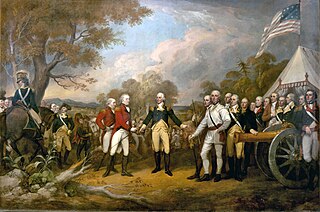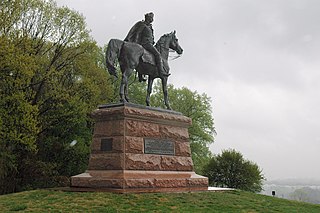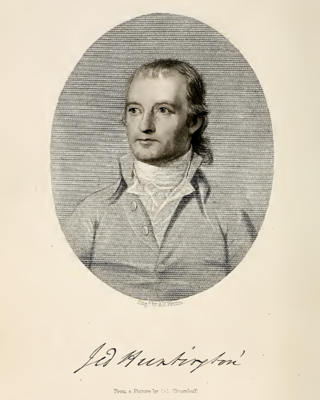Related Research Articles

The Battle of Bennington was a battle of the American Revolutionary War, part of the Saratoga campaign, that took place on August 16, 1777, on a farm in Walloomsac, New York, about 10 miles (16 km) from its namesake, Bennington, Vermont. A rebel force of 2,000 men, primarily New Hampshire and Massachusetts militiamen, led by General John Stark, and reinforced by Vermont militiamen led by Colonel Seth Warner and members of the Green Mountain Boys, decisively defeated a detachment of General John Burgoyne's army led by Lieutenant Colonel Friedrich Baum, and supported by additional men under Lieutenant Colonel Heinrich von Breymann.

The Battles of Saratoga marked the climax of the Saratoga campaign, giving a decisive victory to the Americans, significantly supported by the French, over the British in the American Revolutionary War. British General John Burgoyne led an invasion army of 7,200–8,000 men southward from Canada in the Champlain Valley, hoping to meet a similar British force marching northward from New York City and another British force marching eastward from Lake Ontario; the goal was to take Albany, New York. The southern and western forces never arrived, and Burgoyne was surrounded by American forces in upstate New York 15 miles (24 km) short of his goal. He fought two battles which took place 18 days apart on the same ground 9 miles (14 km) south of Saratoga, New York. He gained a victory in the first battle despite being outnumbered, but lost the second battle after the Americans returned with an even larger force.
General James Inglis Hamilton was a Scottish soldier. He enlisted in the British Army in 1755 and commanded several regiments. He was the only colonel of the 113th Regiment of Foot. During the Seven Years' War (1756–1763), Hamilton fought in the Siege of Fort St Philip, the Raid on St Malo, and the Capture of Belle Île.

The Saratoga campaign in 1777 was an attempt by the British high command for North America to gain military control of the strategically important Hudson River valley during the American Revolutionary War. It ended in the surrender of the British army, which historian Edmund Morgan argues, "was a great turning point of the war, because it won for Americans the foreign assistance which was the last element needed for victory."
The Battle of Hubbardton was an engagement in the Saratoga campaign of the American Revolutionary War fought in the village of Hubbardton, Vermont. Vermont was then a disputed territory sometimes called the New Hampshire Grants, claimed by New York, New Hampshire, and the newly organized, not yet recognized, but de facto independent government of Vermont. On the morning of July 7, 1777, British forces, under General Simon Fraser, caught up with the American rear guard of the forces retreating after the withdrawal from Fort Ticonderoga. It was the only battle in Vermont during the revolution.
Hobart's Regiment of Militia also known as the 12th New Hampshire Militia Regiment was called up on July 21, 1777 at Plymouth, New Hampshire for Gen. John Stark's Brigade gathering at Charlestown, New Hampshire during the Saratoga Campaign. Hobart's Regiment along with Hale's and Stickney's Regiment would assault Friedrich Baum's redoubt from the front (east) during the Battle of Bennington as Nichols' attacked from the rear (west) and Simonds' attacked from the south. Hobart's Regiment would continue on in Stark's Brigade to cut off British Gen. John Burgoyne from retreat or supply after the Battle of Freeman's Farm. The regiment would be disbanded on October 26, 1777 in northern New York.
Chase's Regiment of Militia also known as the 13th New Hampshire Regiment of Militia was called up at Cornish, New Hampshire on September 22, 1777, as reinforcements for the Continental Army during the Saratoga Campaign. The regiment marched quickly to join the gathering forces of Gen. Horatio Gates as he faced British Gen. John Burgoyne in northern New York. The regiment served in Gen. William Whipple's brigade of New Hampshire militia. With the surrender of Burgoyne's Army on October 17 the regiment was disbanded on October 24, 1777. They would be called up again to protect the frontier of the state during the Royalton Raid of 1780.
Bellow's Regiment of Militia also known as the 16th New Hampshire Militia Regiment was called up at Walpole, New Hampshire, on September 21, 1777, as reinforcements for the Continental Army during the Saratoga Campaign. The regiment marched quickly to join the gathering forces of Gen. Horatio Gates as he faced British Gen. John Burgoyne in northern New York. The regiment served in Gen. William Whipple's brigade of New Hampshire militia. With the surrender of Burgoyne's Army on October 17 the regiment was disbanded on October 27, 1777.
May's Regiment of Militia also known as the 2nd Hampshire County Militia Regiment was called up at Southampton, Massachusetts on September 20, 1777, as reinforcements for the Continental Army during the Saratoga Campaign. The regiment marched quickly to join the gathering forces of Gen. Horatio Gates as he faced British General John Burgoyne in northern New York. The regiment served in General Nixon's brigade. With the surrender of Burgoyne's Army on October 17, the regiment was disbanded on October 18, 1777.
Ashley's Regiment of Militia also known as the 1st Berkshire County Militia Regiment was called up in Berkshire County, Massachusetts, in July 1777 and sent for a month to Fort Edward and on September 19, 1777, as reinforcements for the Continental Army during the Saratoga Campaign. The regiment marched quickly to join the gathering forces of General Horatio Gates as he faced British General John Burgoyne in northern New York. The regiment served in General Paterson's brigade.
Bullard's Regiment of Militia also known as the 5th Middlesex County Militia Regiment was called up at Sudbury, Massachusetts on August 16, 1777, as reinforcements for the Continental Army during the Saratoga campaign. The regiment marched quickly to join the gathering forces of Gen. Horatio Gates as he faced British General John Burgoyne in northern New York. The regiment served in General Warner's brigade. With the surrender of Burgoyne's Army on October 17 the regiment was disbanded on October 21, 1777.
Sparhawk's Regiment of Militia, also known as the 7th Worcester County Militia Regiment. The Regiment took its name from its commander, Col. Nathan Sparhawk. The regiment spent the winter of 1776–1777 with Gen. George Washington's main army at Morristown, New Jersey. The regiment was again called up at Barre, Massachusetts on August 16, 1777, as reinforcements for the Continental Army during the Saratoga Campaign. The regiment marched quickly to join John Stark at Bennington, Vermont and then to General Horatio Gates at Saratoga, New York as he faced British General John Burgoyne in northern New York. The regiment served in General Warner's brigade. With the surrender of Burgoyne's Army on October 17 the regiment was disbanded on October 18, 1777.
Cogswell's Regiment of Militia also known as the 3rd Essex County Militia Regiment was called up at Ipswich, Massachusetts on April 19, 1775, during the Battles of Lexington and Concord and to guard the Massachusetts coast from July 1775 to January 1776. The regiment would also be called up on September 20, 1777, as reinforcements for the Continental Army during the Saratoga campaign. The regiment marched quickly to join the gathering forces of Gen. Horatio Gates as he faced British Gen. John Burgoyne in northern New York. The regiment served in Gen. Nixion's brigade.
Cook's Regiment of Militia was called up at Wallingford, Connecticut on August 26, 1777, as reinforcements for the Continental Army during the Saratoga Campaign. The regiment marched quickly to join the gathering forces of Gen. Horatio Gates as he faced British General John Burgoyne in northern New York. The regiment served in General Poor's brigade. With the surrender of Burgoyne's Army on October 17 the regiment was disbanded on November 9, 1777.
Gill's Regiment of Militia also known as the 3rd Suffolk County Militia Regiment was called up at Stoughton, Massachusetts on August 12, 1777, as reinforcements for the Continental Army during the Saratoga campaign. The regiment marched quickly to join the gathering forces of General Horatio Gates as he faced British General John Burgoyne in northern New York. The regiment served in Gen. Warner's brigade. With the surrender of Burgoyne's Army on October 17, the regiment was disbanded on December 12, 1777.
The Van Alstyne's Regiment of Militia, also known as the 7th Albany County Militia Regiment, was called up in July, 1777 at Kinderhook, New York to reinforce Gen. Horatio Gates's Continental Army during the Saratoga Campaign. The regiment served in Brigadier General Abraham Ten Broeck's Brigade. With the defeat of General John Burgoyne's British Army on October 17, 1777, the regiment stood down. It is uncertain whether the regiment participated in the October 7 Battle of Bemis Heights, and if it did, whether the entire regiment was there.
Welch's Regiment of Militia also known as the 10th New Hampshire Militia Regiment was called up at Candia, New Hampshire on September 27, 1777 as reinforcements for the Continental Army during the Saratoga Campaign of the American War of Independence. The regiment marched quickly to join the gathering forces of Gen. Horatio Gates as he faced British Gen. John Burgoyne in northern New York. The regiment served in Gen. William Whipple's brigade of New Hampshire militia. With the surrender of Burgoyne's Army on October 17 the regiment was disbanded on November 8, 1777.

The Philadelphia campaign (1777–1778) was a British military campaign during the American Revolutionary War designed to gain control of Philadelphia, the Revolutionary-era capital where the Second Continental Congress convened and formed the Continental Army and appointed George Washington as its commander in 1775, and authored and unanimously adopted the Declaration of Independence the following year, on July 4, 1776, which formalized and escalated the war.

Jedediah Huntington, was an American general in the Continental Army during the American Revolutionary War. After the war, he served in numerous civilian posts.
Events from the year 1777 in the United States.
References
Sources
- Clay, Steven E. (2018). Staff Ride Handbook for the Saratoga Campaign, 13 June to 8 November 1777 (PDF). Fort Leavenworth, Kansas: Combat Studies Institute Press. ISBN 9781940804347. LCCN 2018008404 . Retrieved 11 Oct 2021.
- Johnston, Henry Phelps, ed. (1997). The Record of Connecticut Men in the Military and Naval Service During the War of the Revolution, 1775-1783. Clearfield. ISBN 0806347422 . Retrieved 11 Oct 2021.